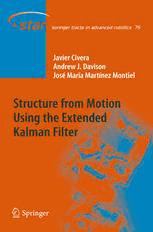
Structure from Motion using the Extended Kalman Filter PDF
Preview Structure from Motion using the Extended Kalman Filter
Springer Tracts in Advanced Robotics Volume 75 Editors:BrunoSiciliano·OussamaKhatib·FransGroen Javier Civera, Andrew J. Davison, and José María Martínez Montiel Structure from Motion Using the Extended Kalman Filter ABC ProfessorBrunoSiciliano,DipartimentodiInformaticaeSistemistica,UniversitàdiNapoliFedericoII, ViaClaudio21,80125Napoli,Italy,E-mail:siciliano@unina.it ProfessorOussamaKhatib,ArtificialIntelligenceLaboratory,DepartmentofComputerScience, StanfordUniversity,Stanford,CA94305-9010,USA,E-mail:khatib@cs.stanford.edu ProfessorFransGroen,DepartmentofComputerScience,UniversiteitvanAmsterdam,Kruislaan403, 1098SJAmsterdam,TheNetherlands,E-mail:groen@science.uva.nl Authors Dr.JavierCivera Dr.AndrewJ.Davison UniversidaddeZaragoza ImperialCollegeLondon InstitutoUniversitariodeInvestigaciónen DepartmentofComputing IngenieríadeAragón(I3A) 180Queen’sGate EdificioAdaByron SW72AZLondon,UK MaríadeLuna,1,50018Zaragoza,Spain E-mail:ajd@doc.ic.ac.uk E-mail:jcivera@unizar.es Dr.JoséMaríaMartínezMontiel UniversidaddeZaragoza InstitutoUniversitariodeInvestigaciónen IngenieríadeAragón(I3A) EdificioAdaByron MaríadeLuna,1,50018Zaragoza,Spain E-mail:josemari@unizar.es ISBN978-3-642-24833-7 e-ISBN978-3-642-24834-4 DOI 10.1007/978-3-642-24834-4 SpringerTractsinAdvancedRobotics ISSN1610-7438 LibraryofCongressControlNumber:2011940008 (cid:2)c 2012Springer-VerlagBerlinHeidelberg Thisworkissubjecttocopyright.Allrightsarereserved,whetherthewholeorpartofthematerialis concerned,specificallytherightsoftranslation,reprinting,reuseofillustrations,recitation,broadcasting, reproductiononmicrofilmorinanyotherway,andstorageindatabanks.Duplicationofthispublication orpartsthereofispermittedonlyundertheprovisionsoftheGermanCopyrightLawofSeptember 9, 1965,initscurrentversion,andpermissionforusemustalwaysbeobtainedfromSpringer.Violations areliableforprosecutionundertheGermanCopyrightLaw. Theuseofgeneral descriptive names,registered names,trademarks, etc. inthis publication does not imply,evenintheabsenceofaspecificstatement,thatsuchnamesareexemptfromtherelevantprotective lawsandregulationsandthereforefreeforgeneraluse. Typeset&CoverDesign:ScientificPublishingServicesPvt.Ltd.,Chennai,India. Printedonacid-freepaper 543210 springer.com EditorialAdvisoryBoard OliverBrock,TUBerlin,Germany HermanBruyninckx,KULeuven,Belgium RajaChatila,LAAS,France HenrikChristensen,GeorgiaTech,USA PeterCorke,QueenslandUniv.Technology,Australia PaoloDario,ScuolaS.AnnaPisa,Italy RüdigerDillmann,Univ.Karlsruhe,Germany KenGoldberg,UCBerkeley,USA JohnHollerbach,Univ.Utah,USA MakotoKaneko,OsakaUniv.,Japan LydiaKavraki,RiceUniv.,USA VijayKumar,Univ.Pennsylvania,USA SukhanLee,SungkyunkwanUniv.,Korea FrankPark,SeoulNationalUniv.,Korea TimSalcudean,Univ.BritishColumbia,Canada RolandSiegwart,ETHZurich,Switzerland GauravSukhatme,Univ.SouthernCalifornia,USA SebastianThrun,StanfordUniv.,USA YangshengXu,ChineseUniv.HongKong,PRC Shin’ichiYuta,TsukubaUniv.,Japan N SdeTrAtRhe(aSupsrpinicgeesrTofraEcUtsRinOANd(vEaunrcoepdeRanobRootbicost)ichsasRbeeseeanrpcrhoNmeottwedorukn)- RERuersoOepaeracBnhROO************TICS NetworkU E To Mar´ıa,Mar´ıaA´ngeles,PedroJose´ and Sergio. To Lourdes, Rafael,Blanca andAdela. To Jose´ Mar´ıaand Olga.To Virginia,Elena andMikel Foreword Robotics is undergoing a major transformation in scope and dimension. From a largely dominant industrial focus, robotics is rapidly expanding into human envi- ronmentsandvigorouslyengagedinitsnewchallenges.Interactingwith,assisting, serving, and exploring with humans, the emerging robots will increasingly touch peopleandtheirlives. Beyondits impacton physicalrobots,the bodyof knowledgeroboticshaspro- duced is revealing a much wider range of applications reaching across diverse research areas and scientific disciplines, such as: biomechanics, haptics, neuro- sciences,virtualsimulation,animation,surgery,andsensornetworksamongothers. Inreturn,thechallengesofthenewemergingareasareprovinganabundantsource ofstimulationandinsightsforthefieldofrobotics.Itisindeedattheintersectionof disciplinesthatthemoststrikingadvanceshappen. TheSpringerTractsin AdvancedRobotics(STAR)isdevotedtobringingtothe research community the latest advances in the robotics field on the basis of their significance and quality. Through a wide and timely dissemination of critical re- searchdevelopmentsin robotics,ourobjectivewith this seriesis to promotemore exchanges and collaborations among the researchers in the community and con- tributetofurtheradvancementsinthisrapidlygrowingfield. ThemonographwrittenbyJavierCivera,AndrewJ.DavisonandJ.M.M.Montiel isdevotedtothewidefieldofcomputervisionforrobotics,whichhasbeenreceiv- ing a great deal of attention by the research community throughoutthe last three decades.Thecontentsarefocusedonthedevelopmentofmodelsandmethodsfor sequentialStructurefromMotionormonocularSLAM,wheretheprojectivenature of the camera is fitted undera Bayesian filtering framework.Pointfeature model, efficient and robust correspondences search, model selection for degenerate con- figurations and internal self-calibration are essential to the theoretical framework underlyingthesequentialestimationalgorithmsdescribedinthebook. X Foreword Sparsepoint-based3Dreconstructionandmotionestimationfromanimagese- quenceareachievedassumingnoknowledgeoverthescenenortheinternalcamera calibrationparameters,makingtheresultingsystemtoeffectivelyworkinreal-time atvideorateintypicalroom-sizedscenarios. STAR is proud to welcome yet another volume in the series dedicated to the popularareaofSLAM! Naples,Italy BrunoSiciliano August2011 STAREditor Preface The book you have in your hands is the result of the joint research of the au- thors from 2006 to 2009, that led to Javier Civera’s PhD thesis. The contribu- tions on it were first published in several international conferences and journals; specifically and in chronological order [Montieletal.2006, Civeraetal.2007a, Civeraetal.2007b, Civeraetal.2008a, Civeraetal.2008b, Civeraetal.2009b, Civeraetal.2009a, Civeraetal.2009c, Civeraetal.2010]. This book provides a unifiedviewoftheresearchspreadonthosepapers,presentingacompleteandro- bustsystemaimedtosequential3Dvisioninreal-time. Alongtheyears,manypeoplehavecontributedinoneoranothermannertothe resultspresentedhere.Firstofall,weareverygratefultoourcoauthorsinthetopics relatedwiththisbookO´scarG.Grasa,DianaR.BuenoandJuanA.Magallo´n.Gabe Sibley andJoan Sola` reviewedthe first versionofthe PhD thesismanuscript.The juryofJavierCivera’sPhDdefence;WolframBurgard,J.D.Tardo´s,PatricJensfelt, MiguelA´ngelSalichsandV´ıctorMun˜oz,contributedtothisfinalversionwithvery insightfulcommentsandannotations.TheexperteyesofAntonioAgudo,O´scarG. Grasa,LinaPazyPedroPinie´salsoreviewedthefinalversionofthisbookandcon- tibutedtopolishsomediscussionsandtofindthelatestandmoredifficultbugs.The authors are also extremely grateful to their respective research groups: the Robot VisionGroupatImperialCollegeinLondonandtheRobotics,PerceptionandReal- TimeGroupintheI3A(Arago´nInstituteonEngineeringResearch)intheUniversity ofZaragozainSpain.Hundredsofrelevantconversations,thestimulatingresearch atmosphereandthededicationatbothgroupsarefertilebreedinggroundsthathave played an essential role in our research. An exhaustivelist of names would be an unfeasibletask,butstillwewouldliketoexpressourgratitudetosomeofourcol- leaguesforveryinterestingdiscussions:Jose´ Neira,PedroPinie´s,LinaPaz,Rube´n Mart´ınez-Cant´ın,LuisMontesano,AlejandroMosteo, Ana Cristina Murillo,In˜aki Ran˜o, Antonio Agudo, Margarita Chli, Hauke Strasdat, Ian Reid, Brian Williams andCyrillStachniss.Lastbutnotleast,weareindebtwithourrespectivefamilies, fortheirconstantsupport. The research results in this book were financially supported by the following sources:TheSpanishGovermentresearchgrantsDPI2003-07986,DPI2006-13578, XII Preface DPI2009-07130andPR2007-0427;regionalgrantDGA(CONAI+D)-CAIIT12-06; theEuropeanUnionprojectsRAWSEEDSFP6-045144andRoboEarthFP7-248942; andA.J.Davison’sERCStartingGrant210346. ZaragozaandLondon JavierCivera July2011 AndrewJ.Davison J.M.M.Montiel Contents 1 Introduction................................................... 1 1.1 StructurefromMotionandMonocularSLAM................... 3 1.1.1 StructurefromMotion................................ 3 1.1.2 MonocularSLAM ................................... 3 1.1.3 StructureoftheProblem .............................. 4 1.2 Background ............................................... 8 1.3 OutlineoftheBook......................................... 9 2 PointsatInfinity:MosaicsUsingtheExtendedKalmanFilter ....... 13 2.1 Introduction ............................................... 13 2.1.1 PointsatInfinity..................................... 13 2.1.2 Real-TimeEKF-BasedMosaicing ...................... 14 2.2 RelatedWork.............................................. 15 2.2.1 SLAM ............................................. 15 2.2.2 Off-LineSFMvs.EKFSLAM ......................... 16 2.2.3 ImageMosaicing .................................... 17 2.3 GeometricalModeling ...................................... 19 2.3.1 FeatureModel....................................... 19 2.3.2 CameraMotionModel................................ 19 2.3.3 MeasurementModel ................................. 20 2.4 SimultaneousLocalizationandMapping ....................... 21 2.4.1 Matching........................................... 22 2.4.2 StateInitialization ................................... 23 2.4.3 FeatureInitializationandDeletion ...................... 23 2.5 MeshingandMosaicing ..................................... 24 2.5.1 UpdatingtheMesh................................... 24 2.5.2 TileTextureMapping................................. 25 2.6 ExperimentalResults ....................................... 26 ◦ 2.6.1 360 PanandCyclotorsion ............................ 26 2.6.2 Real-TimeMosaicBuilding ........................... 29 2.6.3 ProcessingTime ..................................... 30 2.7 Discussion ................................................ 31
